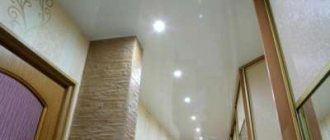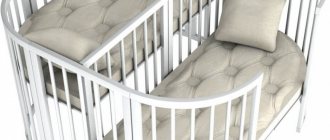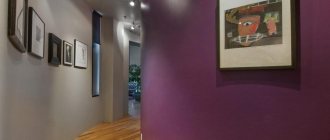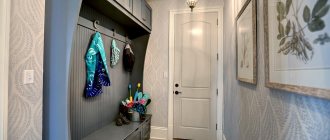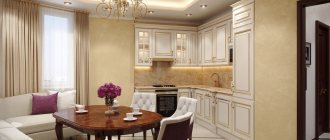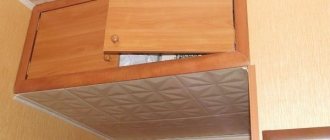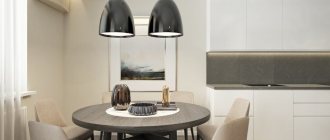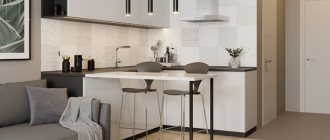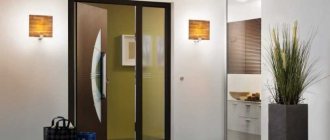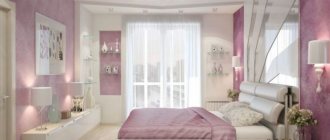When thinking about lighting in the hallway, you need to solve several problems at once: compensate for the lack of natural light, visually increase the area and, finally, make sure that a person, looking in the mirror before leaving, can evaluate his appearance. In this article we will analyze all the features of constructing a lighting scheme with examples.
Listed the main points of the article in the video
Norms and requirements
Despite moving quickly along the corridor, the lack of light can cause a number of inconveniences, as well as its excessive intensity. In this matter, the easiest way is to navigate through adjacent rooms so that a single space is created without sharp changes and contrast.
A number of other rules should also be noted:
- In accordance with the requirements of SanPiN 2.2.1/2.1.1.1278-03 and SP 52.13330.2011, the illumination level in the corridor must be at least 50 Lux. And in places of increased visual load - at least 300 Lux.
- Based on clause 6.6.31 of the PUE, switches for switching lighting devices should be placed at a height of 0.8 to 1.7 m relative to the floor.
- According to clause 7.1.51 of the PUE, the switch must be located on the side of the door handle at the entrance. However, if, in addition to the main lighting in the corridor, other local lighting is used, their switches can be installed in the appropriate zones.
- In accordance with clause 1.7.51 of the PUE, all conductive elements of the luminaire design in normal operation must be connected to protective grounding.
- The location of lighting devices should be as safe as possible so that a person in the room does not catch them.
How to place lamps
When choosing a place for each lamp, you need to make sure that it will not interfere with your dressing and you will not catch it when opening the front door or closet.
There should always be 2.1 m or more from the bottom of the chandelier to the floor. A person who raises his hands when putting on a jacket or taking off a hat should not touch the ceiling light. Therefore, it is better not to hang a chandelier directly above the door.
When choosing wall sconces, make sure that there is at least 80 cm between them and the opposite wall. Also, sconces in the hallway should shine up or down; direct light from sconces or spots can be blinding.
If you use bright wall lights, hang them not at eye level, but 25-30 cm higher.
Selection of lighting fixtures
Thanks to the development of lighting equipment, today you can easily implement any interior design trend.
Among such devices, several categories should be distinguished:
- ceiling lamps - designed for general lighting in the corridor; ceiling-mounted, built-in or suspended options can be used, depending on the type of ceiling and its height;
- wall lamps - used to decorate space, local lighting in the place where you experience visual strain;
- spotlights - equally well suited for local and general lighting, also used as decorative lighting;
- spots - used for directional lighting design of any objects in the corridor (mirrors, paintings and other functional areas);
- LED strips, duralights, neon cords are used as LED lighting, which, depending on the power of the luminous flux, can both provide basic lighting and perform decorative functions.
Photo in the interior of the hallway
Modern lighting design has many functional capabilities that allow you to radically change the visual perception of the hallway interior and create the necessary atmosphere in the room.
Thanks to unusual and original lighting, you can achieve mysterious twilight in a room, give the corridor an unusual volume, or even create a real wall picture using lighting devices.
Mounting options
Both the coverage area and the reliability of operation of the equipment itself will depend on the installation location and method of fastening artificial lighting devices.
Depending on the installation location, mounting options are divided into:
- ceiling lamps;
- wall sconces;
- floor;
- mounted in furniture.
In addition, all corridor lighting devices can have a suspended mounting method, surface-mounted or built-in. Please note that long oversized lampshades hanging from the ceiling or lagging behind the wall should take into account the height and width of the room so that they do not interfere with your free movement around it.
According to the method of fastening, all corridor lighting devices are divided into:
- fixed with dowels;
- bracket mounted;
- pasted on double-sided tape.
The first two methods are suitable for surfaces made of durable hard material. For gluing, the main criterion is the ability of the surface to adhere to the glue.
Nuances for a private home
Unlike an apartment, a corridor in the interior of a house may have a source of natural light in the form of a window. However, in any case, it is necessary to organize the necessary level of artificial lighting. To ensure a uniform light flow, ceiling spotlights are perfect.
The photo shows lighting with spotlights in the hallway of a wooden house.
It is important to take into account all the features of corridor lighting in the house, as incorrect placement of lighting fixtures will deprive the room of warmth and comfort. For example, in the interior of a wooden building, one should take into account the fact that wood has the ability to absorb light. Therefore, in addition to diffuse lighting, you will need to install additional lighting.
Features of lighting corridors of different shapes
Depending on the layout of the home, there are both narrow extended and spacious hallways, which represent a full-fledged room. Accordingly, the lighting of each of them is organized taking into account the geometric parameters and needs of the residents.
Long
Due to the long perimeter of such a corridor, one central chandelier may not be enough, since the light will be localized at a certain interval. It is much more profitable to install several point sources along the entire length of the ceiling or complement the chandelier with several wall spots. The floor can be highlighted with decorative lighting, creating the effect of a runway. To make it easier to turn the lighting on and off in a long corridor, you can place walk-through switches on one or the other side of the entrance.
Narrow
The main problem of a narrow corridor is the psychological discomfort of being in a confined space, which in most apartments is additionally cluttered with hangers, furniture or outerwear. Therefore, lighting in a narrow corridor should be aimed at visually expanding the space.
To do this, they use the effect of reflection and counter-arrangement of low-power LED lamps, creating light zones in those places where you want to emphasize. It is important to take into account the location of all elements that may interfere with the distribution of light.
L-shaped
A feature of L-shaped corridors is the presence of two territorially delimited zones, the arrangement of which can be carried out both jointly and independently of each other. If a small section of the corridor receives uniform lighting from the next room, then you can increase the luminous flux from the hallway by placing a wall lamp opposite. If in an L-shaped room the area around the bend is long, then it would be more expedient to install several lamps or an LED strip along the contour of the ceiling.
Square
In a square corridor you immediately feel an excess of space, which is why you can easily lose space when the walls of the room are lost when lighting accents are turned on. This problem can be solved by installing pendant chandeliers, which will provide uniform lighting along the entire perimeter of the corridor. In addition to the chandelier, you can install several spotlights in the ceiling space. However, this does not mean that you should do without light zones in functional areas.
Low ceiling
In a low corridor, installing pendant chandeliers would be inappropriate; not only will the light not be able to provide effective illumination, but you also run the risk of hitting the structure with your head as you pass by. Here you can place ceiling-mounted plate chandeliers or install sconces and wall spots.
With high ceiling
Ceiling chandeliers located at a great height from the floor will illuminate the ceiling itself, but only a small fraction of the light will reach functionally important areas. Therefore, all lighting fixtures must be lowered a certain distance so that the light accent moves to the lower part of the room. The same effect will be provided by wall lighting fixtures along the perimeter of the corridor; without a central lamp, they will help hide the shortcomings of the upper finish.
Sconces for all occasions in the hallway: ideal complexion and types of sconces
The type of light bulb directly affects the shade of the light and how you will see the reflection in the mirror: sickly and pale or ruddy and full of life. The closer the color of the light bulb is to sunlight, the more pleasant the reflection in the mirror will be. The closest thing to it are LED light bulbs of a neutral white hue, and finding sconces with such a socket will not be difficult.
Suitable here
×
Sconce Globo Lenius 15053W
11 270 ₽
11,270 ₽ buy
Mirror and sconce for the bathroom and hallway
Sconces with classic bulbs can also provide eye-pleasing reflections and natural shades. But this does not apply to office fluorescent lamps. Their cold and flickering light turns the shades into blue, making the skin pale and unhealthy and is not suitable for installation in the home, even in the entrance area.
Option for a composition of a mirror, console table and table lamp for the corridor
Important:
for illuminating mirrors, there are special lamps with several frosted bulbs. They are often found in dressing rooms or stylized loft-style interiors, but such serious lighting is not necessary for the hallway.
Features of lighting depending on the ceiling material
Installation work and the principle of light supply in the corridor also depend on the condition of the ceiling surface. It is important to take into account the reflective or absorptive ability of the latter.
Tensioner
The design of any stretch ceiling provides you with a perfectly flat plane that perfectly reflects light. Both built-in models of lighting devices, hidden behind the canvas, and installed below the ceiling would be appropriate here.
However, in practice there are three types of suspended ceilings:
- Glossy - perfectly reflect the light flux, so you can reflect light from them to the entire space of the corridor. But, at the same time, they will reflect light bulbs and dots from the LED strip located along the perimeter of the ceiling.
- Matte - despite the texture being close to conventional whitewash, they do a good job of reflecting and redistributing light. But reflected dots and other effects will no longer be visible on them.
- Satin - their reflective ability is somewhere in the middle between glossy and matte. However, this option has brilliant inclusions that make for a fun game.
Plasterboard
Suspended ceilings have a good amount of space in which you can place lighting fixtures. Both recessed and pendant lamps are equally appropriate here, but the latter must be mounted on a butterfly dowel or directly under the metal profile. Most plasterboard structures are covered with wallpaper or painted with matte paint, so they absorb much more light than they reflect.
How to choose light for the corridor: universal design tips
When choosing interior elements and lighting, designers are always guided by professional principles. Before you start purchasing light sources, you should understand general organizational issues. 4 important recommendations from experts:
- It is better if the light in the corridor is warm. Cold shades of the spectrum make the room overly formal and uncomfortable. However, some interior styles require just such hallway lighting. In this case, you will have to use a limited number of devices.
- The main criterion for general lighting in the hallway is the brightness of the light. You must be well oriented in space and distinguish all interior items. It is unacceptable to have “blind spots” where the flow does not enter. This should be taken into account when designing the circuit in order to determine the location of the devices in advance.
- It is important to know safety rules and actively use them when creating a lighting project. Lighting devices in the hallway of the apartment should be located so that they cannot be accidentally damaged or moved out of place. This rule is especially relevant in houses where children live.
- You should not combine several completely different lighting sources in one of the hallways. To create an unusual ensemble, it is better to use universal and accent elements. For example, neutral spotlights go well with hanging chandeliers decorated with colored shaped shades.
Important! Designers have a rule - no matter what lighting fixtures are chosen, you need to make sure that there are no glares on the smooth surfaces in the hallway. If there are mirrors in your hallway, it is better to place lamps on both sides of the objects or on top directly above them.
Original lighting in the hallway
Multi-level lighting in the hallway
Organization of general lighting
This function can be assigned to both a chandelier and spotlights. The main criterion for which will be to ensure sufficient brightness of lighting. This does not mean that you will easily read a newspaper; such luminous flux power is unnecessary here; it is enough to distinguish all the elements of the interior well enough. Installation of LED spotlights or chandeliers should be carried out according to a pre-designed lighting scheme so that the fastening elements do not damage the wiring lines. If the hallway is long enough, you can install several chandeliers in a row, dividing the entire space into several conventional zones.
Fabric or PVC film?
To make a choice, it is necessary to consider in detail the features of fabric models and PVC sheets. The fabric is made of polyester fibers impregnated with polyurethane.
Advantages
Flaws
Fabrics
PVC
Organization of local lighting
In addition to the main lighting, in some corridors it would be appropriate to organize local lighting for the comfort of the interior or the design of a functional area. Next, we will consider the most relevant positions for such zones.
Mirrors
A mirror in the hallway helps you complete the finishing touches before leaving the house, fixing your hair or assessing how a new dress fits. Therefore, visibility in this area should be sufficient for applying makeup and performing minor work. To illuminate the mirror, you can install several sconces on the walls on both sides or one spot on top. If the mirror in the hallway is part of the furniture hallway, you can embed a rotating soffit above it.
Paintings
Decorating a hallway with paintings, photographs, or framed displays is a great design option. And to see them in pitch darkness you need to use night lighting. The best option is directional lighting devices installed on top of the paintings; matte shades are used for them so that the light does not create glare on the surface of the painting. In some hallways, picture lighting can be mounted on the ceiling.
shelves
Shelves, as a place to store some things, clothes or shoes, can be decorated with a lamp with a decorative shade, built-in spotlight or LED strip. Regardless of the location of the shelf itself, an important criterion for its lighting will be the direction of the lighting flow so that the light does not blind those nearby.
Stairs
The staircase adjacent to the corridor is illuminated with side or front lamps on each step or every few. You can also place a central chandelier or sconce away from the wall. An important requirement is the direction of the light flow, in which the lighting should not blind anyone entering the corridor or moving along the stairs.
Additional wall lighting
This element is not necessary, but with its skillful use the hallway becomes more beautiful and cozy. Light bulbs on the walls will complement the ceiling lighting.
Sconces are often hung on the sides of the mirror. This way the face is illuminated more evenly, without shadows from below.
If there is a shelf for small items or a hanging key holder, it is useful to highlight it too. Lighting for paintings and photographs can also be placed on the wall, but it is better from above, directing the light beam downwards. A spot or small narrow LED lamp will do.
Decorative lighting
Used to decorate a corridor or highlight its individual components. The most suitable options are to install LED strip or flexible neon around the perimeter of the ceiling, in the floor plinth, under doorways, furniture or photo frames. You can also use spotlights above vases, chests of drawers, shoe racks in the hallway, and built into the wall at floor level they will help replace night lights.
No. 7. What else needs to be considered?
The issue of hallway lighting must be approached responsibly, and in order to organize a comfortable and harmonious space, it is better to think in advance about the layout of each lamp and switch, and even better, to depict all this on paper along with a plan for the arrangement of pieces of furniture.
Although the hallway in most cases does not have its own windows, sunlight can penetrate into it from neighboring rooms . To take advantage of this opportunity, you can refuse, for example, the door to the living room or kitchen, designing the doorway in the form of an arch. You can use all-glass doors or door leaves with glass inserts.
Lights with a motion sensor will help you save on energy bills , which will light up only when there are people in the hallway. The advantages are noticeable to the naked eye: there is no need to look for a switch in the dark, and it will be impossible to forget to turn off the light. Such automation today does not cost much, so it is available to almost everyone.
